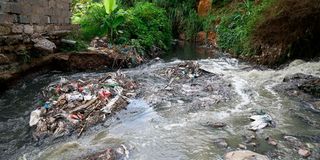Effluent from estates blamed for pollution of River Athi: Nema report

Sewage spills into the Athi River in Shiranga, Njiru Ward on 31 May 2023.
Effluent of solid wastes from residential estates, slaughterhouses, dumpsites and municipal sewers have been identified as the leading pollutants of the river, according to a report by the National Environmental Management Authority (Nema)
According to the report which has been presented before the National Assembly Public Petitions Committee, most industries in the area which were initially blamed for the pollution of the river have all complied with the environmental conditions for managing their wastes.
The report has identified wastes from informal settlements into the river and effluent and solid wastes, poor agricultural and livestock practices, residual pesticides, silt, organic and inorganic fertilisers, quarrying and sand harvesting activities as the major contributors to the pollution of the river.
The report has singled out wastes from Kibera, Mukuru slums, Tassia, Pipeline, Eastleigh Section 3, Kiambiu slum, Githurai 44 and 45, Dandora dumpsite, Korogocho, Kahawa Wendani, Mlolongo town, Athi river town, Machakos town, Wote town, Kibwezi, Mtito Andei Townships, Voi town, Mwatate and Mbololo.
Further, the report from the environmental body has also identified horticultural and coffee plantations in Thika, Ruiru and Matungulu, Kibwezi, Mua, Iveti, Kangundo and Matungulu hills, Coffee factories in Kiambu, Thika, Ruiru, Matungulu and Kangundo, Horticultural farming in Taita hills, Ranches in Taita, Galana ranch as other pollutants of River Athi.
Other pollutants mentioned in the report include Juja quarries, Ruiru dumpsites, Yatta and Mwala, Kaiti, Muooni, Kikuu, Kambu Rivers sand harvesting sites, Syanthi-Kathaana quarries, Voi sand quarrying,
The report also identified bursting and blockages of sewers at St. George’s primary school sewer line, Muthurwa sewer line, Donholm-Tassia bridge sewer line, Murang’a Road (Globe cinema) sewer line, Umoja-Dandora sewer line, Inside Kenya science campus sewer line, inside Museum’s compound (Kipande road), In Lang’ata off southern bypass, Kiambu sewerage system, Maruba area sewer line (Machakos), EPZ sewer line (Athi River) as other pollutants of the river.
Non-functional effluent waste facilities include Ruai treatment works, Industries in Nairobi, Machakos treatment works, EPZ treatment works in Athi River, pumping stations (bridge 39) and Alfarama pumping station, Machakos Grogan pump station, Voi sewage stabilization ponds.
The Dandora dumpsite, Pit latrines in informal settlements, Machakos dumpsite, Wote dumpsite, Kiambu dumpsite discharge untreated sewage into the river.
“Pollution of this River and its tributaries has raised both scientific and environmental concerns among the regulatory authorities and research institutions,” reads the report.
The committee is investigating the causes of the pollution of the river following a petition filed in the National Assembly filed by Mwala MP Vincent Musyoka on behalf of the area residents.
Appearing before the committee last week, Interior Cabinet Secretary Kithure Kindiki blamed industries for polluting the river.
He told the committee that a multi-agency team will be meeting soon to identify polluters.
“A crackdown on all the polluters will be done and those found culpable made to compensate those affected by the waters,” he told MPs.
The River is of socioeconomic significance used for domestic water, fisheries, wildlife and agricultural purposes among others. If the pollution is left unchecked then more lives will be at risk.
Kindiki told MPs that millions of people who use water from the River Athi were living in danger of contracting harmful ailments after studies by government and private experts found that the waters contain heavy metals and carcinogenic substances.
He said that studies by the Government Chemist and private scientific research have shown that River Athi is infused with heavy metals, industrial, biomedical and human wastes.





